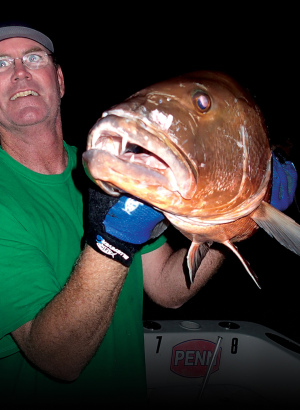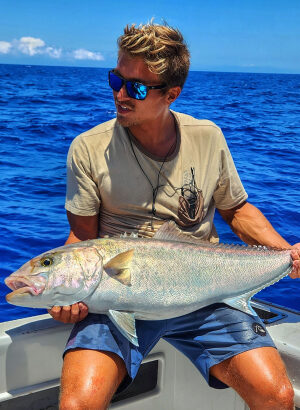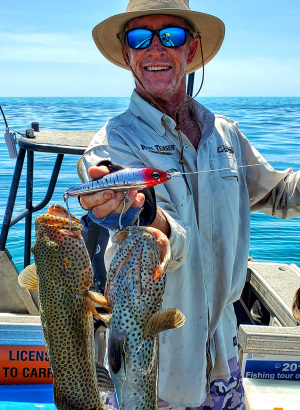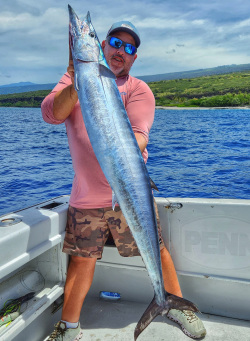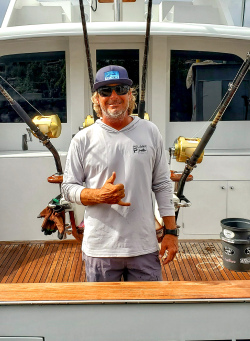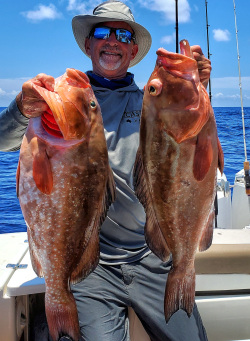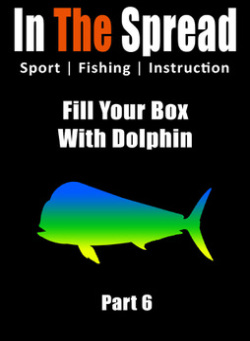Capt. Patrick Smith is a South Florida fishing guide specializing in reef fishing, blackfin tuna, kingfish, snook, bowfin, largemouth bass, peacock bass, and gator hunting. He teaches simple, straightforward methods for catching gamefish, using live and hooked baits, and demonstrating jigs and poppers.
Reef Fishing - Trolling South Florida Nearshore
(00:52:19)- The Florida Reef System is the largest coral reef ecosystem in the continental United States
- The reef system stretches approximately 350 miles from the Florida Keys to Jupiter
- It is the third largest natural reef in the world
- The reef system includes natural reefs, wrecks, and artificial structures
- Anglers can expect to encounter a diverse range of species, including porgies, snapper, grouper, kingfish, blackfin tuna, dolphin, amberjack, African pompano, sailfish, wahoo, and more
- Fishing techniques include trolling, kite fishing, live baiting, jigging, drifting, and anchoring
- Capt. Patrick Smith shares his expertise and insights on reef fishing in the latest In The Spread Fishing Video
Along the Atlantic coast of Florida lies the Florida Reef System, the largest coral reef ecosystem in the continental United States. Stretching approximately 350 miles from the Florida Keys to Jupiter, it stands as the third largest natural reef in the world. Interspersed within this natural marvel are numerous wrecks and artificial structures, providing anglers with an impressive array of fishing spots.
Fishing Opportunities
Reefs and wrecks offer some of the best fishing opportunities in Florida. Anglers can expect to encounter a diverse range of species, including:
- Porgies
- Snapper, such as mangrove snapper
- Grouper, particularly gag grouper
- Kingfish
- Blackfin tuna
- Dolphin (mahi-mahi)
- Amberjack
- African pompano
- Sailfish
- Wahoo
- Spanish mackerel
For those targeting bottom fish, the reefs are home to various species of snappers and groupers. Mangrove snapper, known for their delicious taste, can be found around the reefs and wrecks. They are often caught using live or cut bait, and light tackle provides an exciting fight. Gag grouper, another popular target, are known for their size and strength. They often lurk around structures, waiting to ambush their prey.
Pelagic species also frequent the waters above the reefs. Kingfish, also known as king mackerel, are notorious for their blistering runs and can be caught trolling or live baiting. Blackfin tuna, although smaller than their yellowfin and bluefin cousins, are a blast to catch and make for excellent table fare. Dolphin, or mahi-mahi, are another favorite among anglers. These colorful fish are often found around floating debris or weed lines and can be caught trolling or on light tackle.
For those looking for a true challenge, the reefs also attract some of the ocean's most prestigious game fish. Sailfish, with their spectacular aerial displays, can be found in the waters off Florida's coast, especially during the cooler months. Wahoo, known for their incredible speed and razor-sharp teeth, are another prized catch. They can be taken trolling at high speeds with heavy tackle.
The variety of fishing methods that can be employed in these waters is equally diverse. Trolling allows anglers to cover a lot of ground and is effective for targeting pelagic species. Kite fishing, a method popularized in South Florida, enables anglers to present live baits on the surface, away from the boat. This is particularly effective for sailfish and kingfish. Live baiting, either on the bottom or under a float, is a proven method for a variety of species, particularly snappers and groupers.
While having a wide array of tackle can be advantageous, it's not always necessary. Many anglers find success with a simple setup - a single rod and reel, a few lures or baits, and a lot of patience. The key is to fish within your abilities and to respect the environment and the fish.
Regardless of your target species or preferred method, the reefs and wrecks of Florida's southern Atlantic coast offer an unforgettable fishing experience. With the right knowledge and a bit of luck, anglers can enjoy the thrill of a big catch in one of the most diverse and productive fishing grounds in the world. Just remember, as with all fishing, it's important to follow local regulations, practice catch and release when appropriate, and to fish responsibly to ensure these wonderful resources are available for generations to come.
Capt. Patrick Smith Shares His Expertise
In our latest fishing video, we collaborate with Capt. Patrick Smith. Patrick isn't one for the limelight, but his reputation as a top-tier fisherman is undeniable. With over 300 fishing days a year, Patrick's expertise spans from nearshore reefs to freshwater fishing and even gator hunting.
In this video, Patrick shares insights on:
- Catching bait
- Using electronics for fishing
- Setting up a drift
- Live chumming
- Using jigs and poppers
- Determining how long to stay in an area
- His preferred tackle for everyday fishing
Fishing Depths and Drifts
The depth range along the Florida reef system, from 20 feet to 300 feet, offers a wide spectrum of fishing opportunities. Each depth presents its own challenges and rewards, and understanding how to approach these different zones is key to successful fishing.
In shallower waters around 20-50 feet, anglers can target a variety of reef fish such as snappers, grunts, and porgies. These areas are often more accessible and can be fished with lighter tackle. However, shallower waters are also more susceptible to the influence of wind and waves, which can make boat positioning and drift management more challenging.
As you move into deeper waters, from 50 feet to 150 feet, you enter the realm of larger predators like groupers, amberjacks, and kingfish. These fish often associate with larger structures such as wrecks or substantial coral formations. Fishing these depths requires heavier gear and more precise boat positioning.
Beyond 150 feet, you start to encounter the true deep-water species like blackfin tuna, sailfish, and wahoo. These fish are often found around deep-water structures or temperature breaks. Fishing these depths requires specialized equipment and techniques, such as deep-dropping or high-speed trolling.
Regardless of the depth, managing your drift is crucial for successful fishing. The Gulf Stream, a powerful ocean current that flows along the Florida coast, can have a significant impact on your drift. It can push your boat off your intended spot or cause your baits to move unnaturally.
To counter this, Capt. Patrick Smith shares valuable insights on how to position your boat relative to the current and structure. One key technique is to approach the structure up current, allowing your baits to naturally drift back towards the fish. This presents a more natural presentation and increases your chances of a strike.
Another important factor is the use of a sea anchor or drift sock. These devices help slow your drift and maintain a more controlled position over the structure. They are particularly useful in deep water or strong currents.
Capt. Smith also stresses the importance of using your electronics to mark productive spots and to keep your boat in the right position. Modern fish finders and GPS units allow anglers to precisely mark structures and fish, and to maintain their position with the help of features like spot lock or drift lines.
Ultimately, successful reef fishing in Florida is about understanding the depths, the currents, and the structures, and adapting your techniques to the conditions. By applying the insights shared by experienced anglers like Capt. Patrick Smith, you can unlock the vast potential of the Florida reef system and enjoy the thrill of a big catch, no matter what depth you're fishing.
Understanding Fish Behavior
Different fish have different behaviors. For instance:
- Snapper, kingfish, and blackfin tuna tend to stay down current.
- Larger predators like grouper and amberjacks are often found up current.
As Capt. Patrick Smith points out, snapper, kingfish, and blackfin tuna tend to position themselves down current of structures. This is because these fish often feed on smaller baitfish that are carried by the current. By positioning themselves down current, they can easily ambush their prey as it's swept past them.
On the other hand, larger predators like grouper and amberjacks are often found up current of structures. These fish are powerful swimmers and often use the current to their advantage. They will position themselves facing into the current, allowing them to efficiently oxygenate their gills and conserve energy. From this position, they can easily dart out to grab passing prey.
Knowing these behaviors can inform your fishing tactics. For example, when targeting snapper or kingfish, you might position your boat up current of the structure and allow your baits to drift back naturally with the current. For grouper or amberjacks, you might try dropping your baits up current of the structure and allowing them to sink down to the fish.
In addition to understanding fish behavior, the use of electronics is invaluable for identifying productive fishing spots. Modern fish finders use sonar technology to provide detailed images of the bottom structure and fish. They can help you locate wrecks, reefs, or other structures that are likely to hold fish.
Many high-end fish finders also include features like side-scanning and down-scanning, which provide even more detailed images of the surrounding area. These features can help you locate individual fish or schools of bait, allowing you to precisely target your efforts.
Once you've located a promising spot, the use of live chum can be a game-changer. Chumming involves releasing small bits of cut bait or live bait into the water to attract fish. This can draw fish out of the structure and get them actively feeding.
Live chum is particularly effective because it mimics the natural behavior of injured or disoriented baitfish. Predatory fish are hardwired to investigate and attack this type of prey. By presenting your baits in the midst of a live chum slick, you can entice even the wariest fish to bite.
Of course, chumming should be done responsibly and in accordance with local regulations. Excessive chumming can disrupt the natural balance of the ecosystem and lead to problems like overfishing or attracting unwanted species.
Ultimately, successful reef fishing is about understanding the fish, reading the environment, and adapting your tactics accordingly. By combining an understanding of fish behavior with the strategic use of electronics and techniques like live chumming, anglers can unlock the full potential of the rich and diverse ecosystem of the Florida reef system. As with all fishing, it's important to fish responsibly, respect the environment, and follow all local regulations to ensure that these resources remain healthy and productive for generations to come.
Reef Fishing Techniques and Tackle
What is the best time of year for reef fishing in Florida?
While you can enjoy reef fishing year-round in Florida, the spring and summer months (April to August) are considered the peak season. During this time, the weather is generally more stable, and the waters are warmer, attracting a wide variety of fish species.
Do I need a fishing license for reef fishing in Florida?
Yes, if you're fishing from a private boat, you need a Florida saltwater fishing license. If you're fishing with a licensed charter or guide, you're covered under their license. You can purchase a license online from the Florida Fish and Wildlife Conservation Commission.
How can one ensure they're fishing in the right spot?
Using electronics can help determine if the grounds are holding fish. Observing how fish relate to the structure and understanding their behavior in relation to the current can also provide insights.

